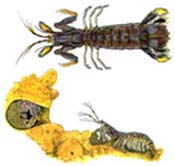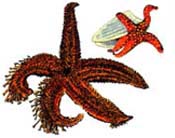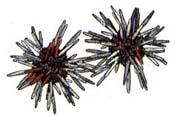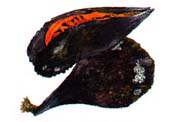 |
Mantis Shrimp – Squilla empusa, So named for its preying mantis, insect-like appearance, it burrows in mud bottoms below the tides, slashing out at passing fish and shrimp with its razor sharp striking claws. At night it emerges from its lair to swim, and in turn becomes food for small sharks, rock bass, sea turtles and other large predators. Subphylum: Crustacea, Order: Stomatopoda |
 |
Moon Snail – Polinices duplicatus Crawling beneath the sand, leaving a furrow, moon snails or "cat's eyes" have a greatly expanded foot which they use to engulf bi-valves; they drill through their shells with a moving ribbon of rasping teeth. A circular "collar" of eggs cemented with sand grains can often be found on the low tidal flats in Spring and Summer. Class: Gastropoda, Family: Naticidae/moon & ear shells |
 |
Orange Starfish – Echinaster spinulosus This denizen of the grass beds was once one of the most abundant of starfish, but for unknown reasons has rapidly declined along the West Coast of Florida. The young often hide in oyster shells, and feed on encrusting sea pork. Class: Stelleroidea, Sub-class: Asteroidea |
 |
Pencil Urchin – Eucidaris tribuloides A primitive tropical urchin, it has large pencil thick spines which it uses to wedge itself tightly into rocks. Found abundantly in the shallow waters of the Florida Keys it is occasionally caught in shrimp nets in deep water twenty miles off St. George Island, where the water is stable and warmer year round. Class: Echinoidea |
 |
Pen Shell – Atrina rigida or Atrina serrata This triangular bi-valve lives in grass beds, anchoring itself deep into the mud with a golden tuft of interwoven, protein threads. Only an inch or two of the top of the shell shows above the sand, often covered with sponges, barnacles and tube worm's shells. A pea crab sometimes lives inside the valves. Class: Pelecypoda, Family: Pinnidae/pen shells |
| « Previous | Next » |





